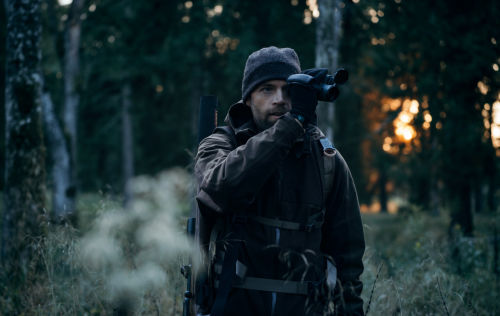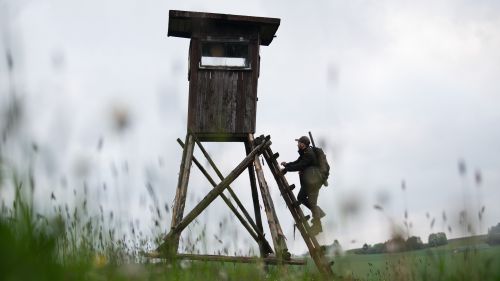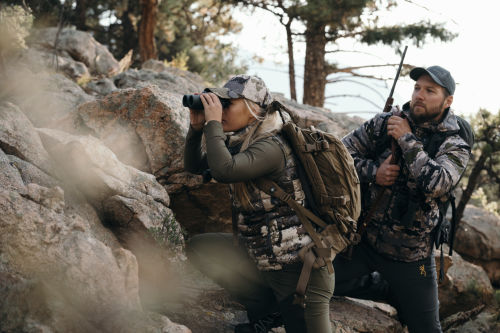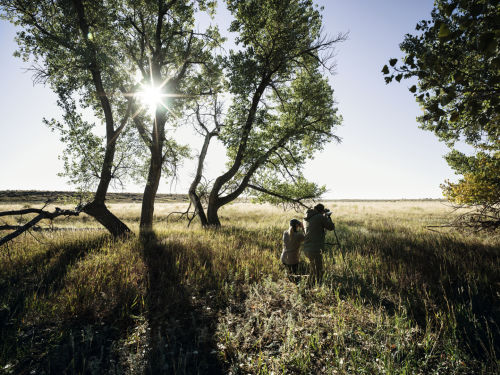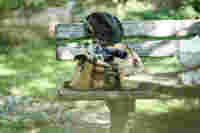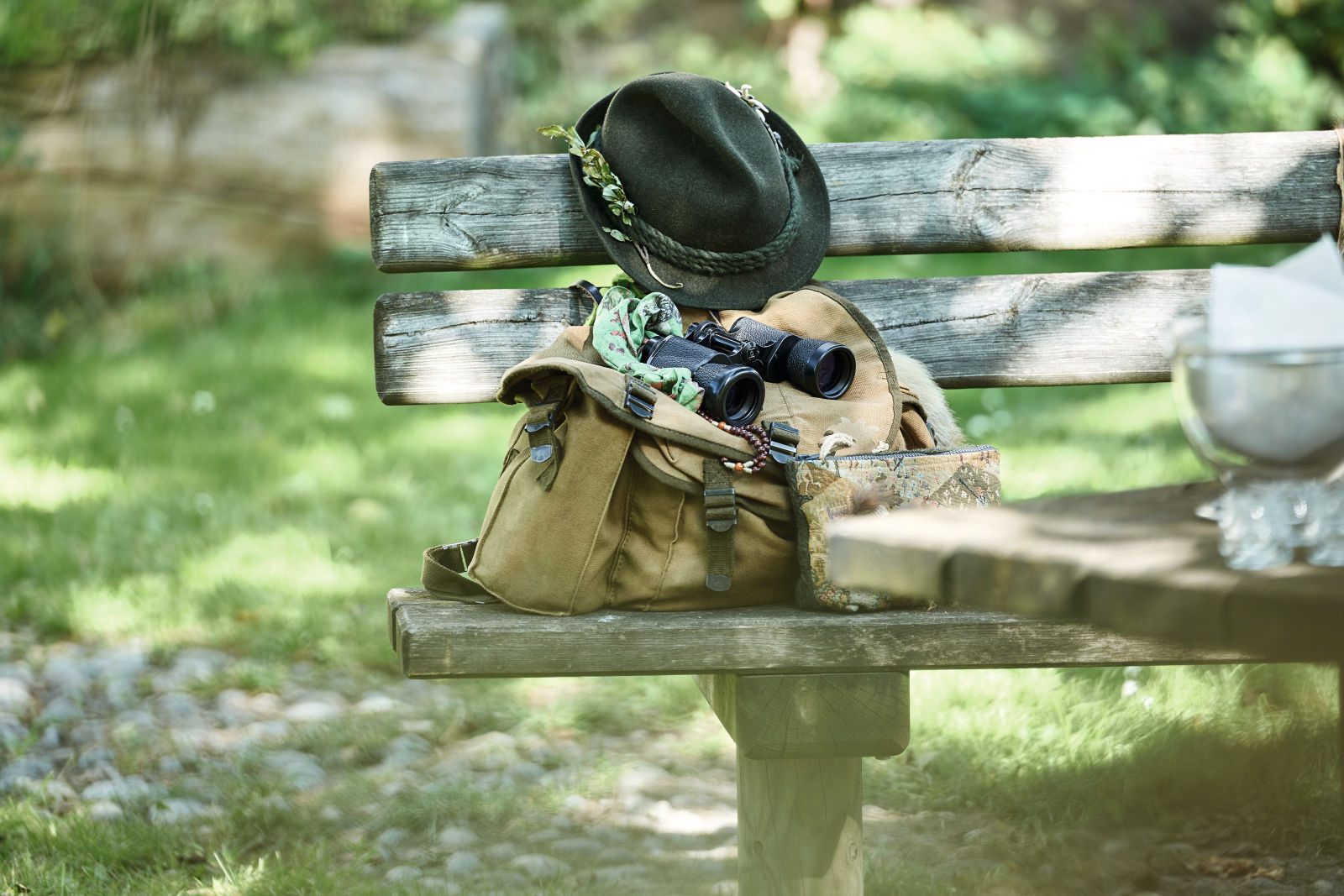Much of what Barbara Hoflacher does and says might appear contradictory at first: She is a hunter and yet a vegetarian. She works in pediatric radiology at the Innsbruck Kinderklinik and practices herbal medicine in her outdoor school. She loves the mountains and enjoys living in the city. She is fascinated by traditional remedies and researches game fats on a scientific level.

On a beautiful, sunny September day, Barbara Hoflacher took us on a journey. She not only showed us a gloriously scenic spot in the midst of the Tyrolean Alps and shared her knowledge of the “Wild Pharmacopeia,” but also sent our thinking in a new direction.
How did you, a confirmed vegetarian, decide to become a hunter and eat the game meat from animals you kill yourself?
I decided to adopt a vegetarian lifestyle 25 years ago as a reaction to large-scale livestock farming, animal transport, and so on. Then when I took the hunting examination, purely out of an interest in wild animal biology, I never considered hunting myself. However, fate placed me alongside a hunting guide who led me to a roebuck. At first, I didn’t realize that I’d actually shot it. I just noticed that the animal was no longer in my sights. Then I heard, “Good hunting! Nice shot. Well done. Now you can feed your family,” and I realized that they meant me. I will never forget how I then ate the meat from the roebuck and had the indescribable feeling that I was consuming the soul of the animal too. And since then, I have eaten the meat of animals shot by me or my friends.
In your opinion, what makes someone a good hunter?
Mindfulness, respect, and compassion for every living creature. For me, it is essential that you don’t just hunt for the sake of shooting something, perhaps just for the trophy, leaving the animal lying there, or in the garage, the basement, or the animal rendering plant, but that you use as much as possible, if not all, of the animal. That simply makes sense to me and provides my personal justification for hunting.
Could you regard that as “sustainability in hunting”?
Yes, absolutely. Let’s look at the example of the marmot that I was able to shoot. In this case, my hunting colleagues and I really do use everything. When we shoot one, the liver, heart, and kidneys are cooked that evening, if they are not given to the dog that hunted with me. As the marmot is a herbivore and does not have trichinella parasites, there is no need to examine it further. I immediately remove the visceral fat for my ointments. It is then skinned and we eat the game meat, right away. In ancient literature, great healing power is attributed to the hide, said to help especially with rheumatic aches and pains, and I use the teeth to make jewelry like this necklace. The residue left after the fat is rendered is either used as fox bait or for cat or bird food. The entire animal is used and the circle of life is closed.
You run your “Hunting Pharmacopeia” scientifically. How did that come about?
I trained in aromatherapy and wanted to research a new field for my dissertation. Because we’re here in the Alps, I had marmot oil to hand and later added deer, badger, and fox too. Since then, I have conducted intensive research in this field, referring not only to ancient literature such as Paracelsus, Lonicerus, or Hildegard of Bingen, but also looking at the scientific aspects. I have received fantastic support from Professor Teresa Valencak at the University of Veterinary Medicine in Vienna, who took an immediate interest in the project. For my game fat investigations, I always send her one raw and one rendered sample so that we can assess whether heating alters the fatty acid pattern. The analysis has shown that the water bath method does not change anything, meaning that everything is retained. And so I can use my knowledge to interpret the fatty acid analysis and compare the ancient literature with scientific findings. I am a student of nature; I’m not an expert. I research and I always want to learn, recognize, and understand more, so that I can document and pass on this knowledge.

Czego dokładnie dotyczyły Pani badania i jak można wykorzystać to, co udało się Pani odkryć?
Wiele zwierząt jest bogatym źródłem wielonienasyconych kwasów tłuszczowych, takich jak Omega-3 i Omega-6, które są niezbędnymi składnikami zdrowej diety. Tłuszcz świstaka ma niemal taki sam profil kwasów tłuszczowych, jak olej lniany, który, podobnie jak te zwierzęta, źle znosi wysokie temperatury. Tłuszcz każdego dzikiego zwierzęcia posiada wyjątkowe właściwości. Tłuszcz borsuka i świstaka zawiera podobne związki, zwane glikokortykoidami. Są to substancje zbliżone do kortyzonu, które działają przeciwbólowo i przeciwzapalnie na nasz organizm. Można z nich sporządzić lecznicze maści, kremy do opalania, a nawet dezodorant niezawierający aluminium. Łój kozicy zawiera na przykład znaczne ilości kwasu stearynowego i może być używany do produkcji bezdymnych, długo palących się świec. Łój jelenia, sarny i dzika jest wspaniałą bazą do produkcji mydła o działaniu kojącym. Znana jest również receptura pasty do obuwia na bazie łoju jelenia. Rogi jelenia i koziorożca alpejskiego można użyć do okadzania i dezynfekowania pomieszczeń. Skóra borsuka normalizuje mikrokrążenie i sprzyja leczeniu choroby tętnic obwodowych. Możliwości są wprost niewiarygodne.
Jakie efekty Pani zaobserwowała?
Podam świetny przykład: moja przyjaciółka doznała poważnych oparzeń ciała na odcinku od uda aż do miednicy. Zadzwoniła do mnie z pytaniem, czy mogłabym jej coś polecić. Skończyłam właśnie przygotowywać świeżą partię oleju z łoju borsuka, zaproponowałam więc, żebyśmy połączyły siły i sporządziły z niego maść. Do maści dodałyśmy różne olejki znane z kojącego działania na poparzoną skórę. Kiedy przyjaciółka poszła do dermatologa na kontrolę, oniemiał, ponieważ tam, gdzie przedtem było rozległe oparzenie, nie pozostała niemal żadna blizna. Nawet w świetle słonecznym nie widać żadnych przebarwień, które są częstym następstwem oparzeń.
Pani głównym miejscem pracy jest Klinika Dziecięca w Innsbrucku. Czy Pani zdaniem istnieją zbieżności między medycyną konwencjonalną a medycyną alternatywną?
Niezmiernie się cieszę, że zabiegi takie jak aromaterapia, w których olejki roślinne są kluczowym składnikiem, mają już ugruntowaną pozycję w medycynie konwencjonalnej. W szpitalu w Innsbrucku co najmniej 50% instytutów i oddziałów oferuje aromaterapię, jeśli pacjent się na nią zdecyduje. Pracuję na przykład z chirurgiem plastycznym, który jest wielkim zwolennikiem stosowania aromaterapii, a nawet olejów pochodzenia zwierzęcego w leczeniu blizn. Chciałabym w tym miejscu podkreślić, że niczego nie sprzedaję; po prostu przekazuję swoją wiedzę, prowadząc kursy, które umożliwiają zainteresowanym samodzielne wykonanie preparatów.
W ostatnich latach można zauważyć, że ludzie na całym świecie coraz bardziej skupiają się na przyrodzie. Skąd bierze się ta ogromna potrzeba, ta tęsknota?
Wydaje się, że wszystko to, co ma związek z naturą, pozwala nam zbliżyć się ponownie do naszego wewnętrznego świata uczuć. Innymi słowy, można odnieść wrażenie, że wielu osobom doskwiera to oderwanie od natury. Amerykanie nazywają to „zaburzeniami związanymi z deficytem natury”. Zaczynamy dostrzegać, że to oddalenie nie sprzyja naszemu zdrowiu – wręcz przeciwnie, jesteśmy coraz bardziej schorowani, coraz bardziej przygnębieni. Wierzę, że jakaś część naszego ja wciąż pamięta o tym, że zanim 10 000 lat temu zaczęliśmy prowadzić osiadły tryb życia, przez tysiące lat byliśmy koczownikami – myśliwymi i zbieraczami – i że wspomnienie o tym tkwi zapisane gdzieś głęboko w naszych komórkach. Byłoby wspaniale, gdyby ludzie, którzy decydują się na powrót do natury, starali się także odpowiednio ją szanować. Jednak większość osób coraz częściej uświadamia sobie, jakie korzyści może czerpać z przyrody i co może dla niej zrobić w zamian. Nie sądzę też, żeby to było takie złe, bo wierzę, że przyroda zawsze zwycięży. Pytanie brzmi nie, czy przyroda nas przeżyje, tylko czy nasi potomkowie będą w stanie żyć godnie w otoczeniu przyrody, jaką im zostawimy.
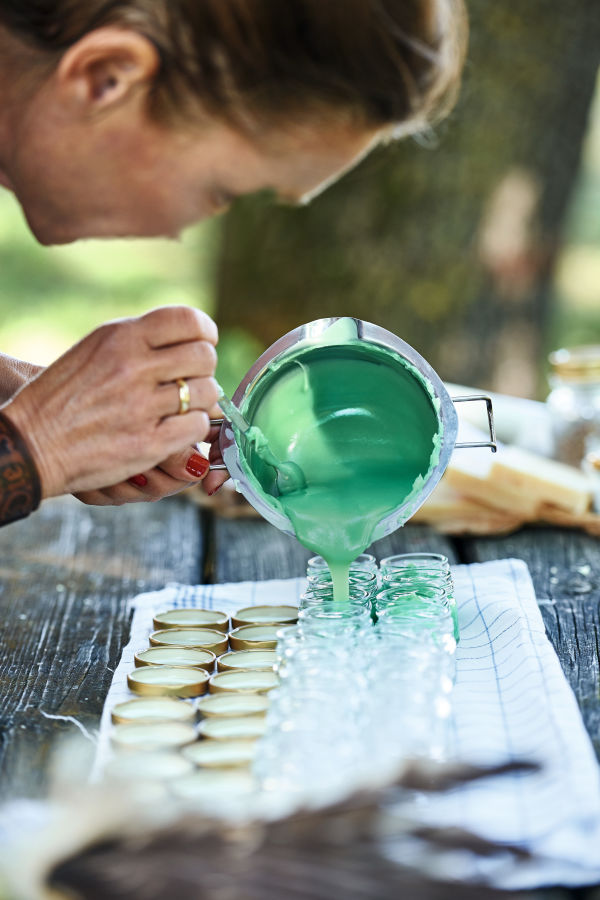
MARMOT HEALING OINTMENT
This ointment helps with
RHEUMATISM, CALCIFIED SHOULDER, ARTHRITIS, ARTHROSIS, COUGHS, HOARSENESS
Recipe marmot healing ointment
- 250 ml (8.8 fl oz) marmot oil (from the visceral and muscle fat of a marmot)
- 50 g (1.76 oz) certified organic beeswax
- 50 drops of the purest-quality organic mountain pine or Swiss stone pine essential oil
- a little bit of organic stinging nettle chlorophyll of the purest quality
The recipe can be scaled up or down as required to suit the quantity of oil you start with.
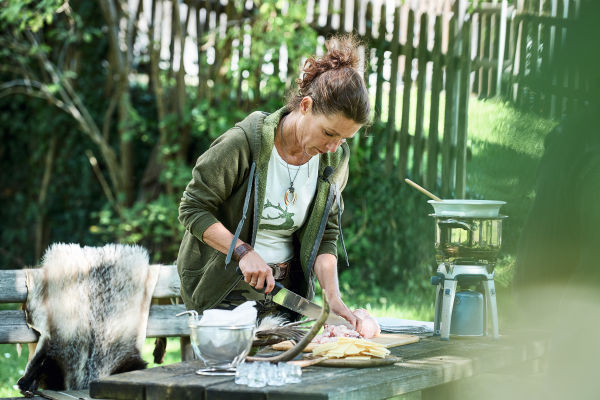
1.
To make the ointment,
first chop the muscle fat and visceral fat finely. Hygiene is of paramount importance, not only when making the ointment, but the animal should be butchered within no more than 20 minutes & the fat should be refrigerated immediately.
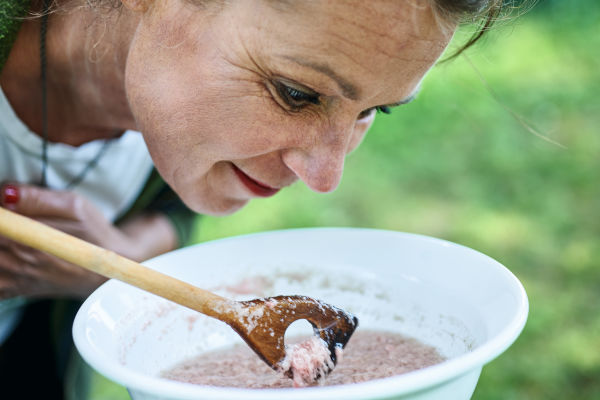
2.
Mince the fat
as finely as possible using a food processor or meat grinder. This allows the pureed fat, which resembles strawberry milk, to be processed without the need to heat it.

3.
Render the fat
very slowly in a water bath, making sure that the temperature is not too hot, in order to retain the valuable polyunsaturated fatty acids. This separates the connective tissue from the oily portion.

4.
Then carefully pour off the oil,
ensuring that it does not come into contact with any water as this would spoil it.
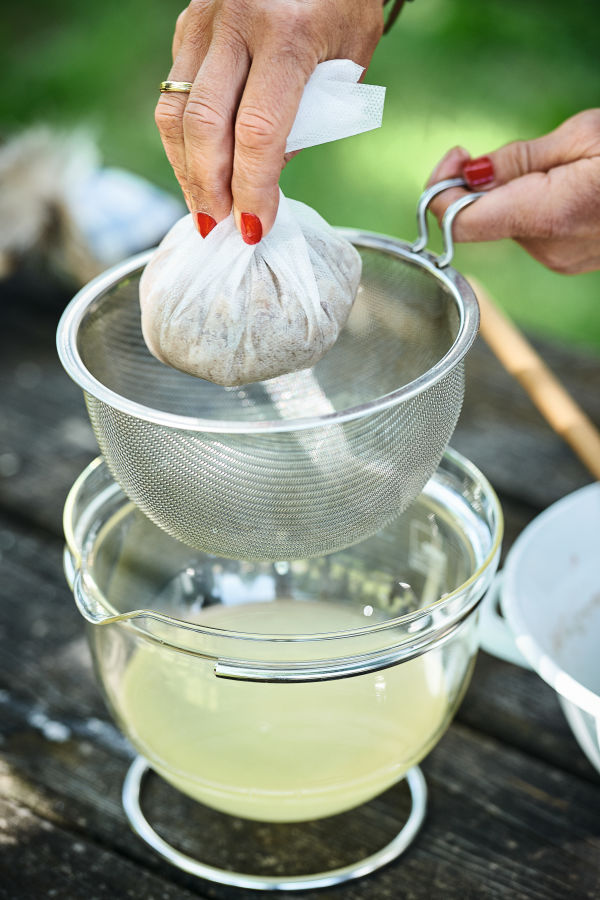
5.
Pass the oil
through a sieve. Do not press it through, as this would allow tissue fragments into the oil, which could lead to mold.

6.
The residue
can be fed to dogs, cats, or birds, or it can be used as fox bait – completing the circle of life.

7.
This is what the finished oil looks like
– it is clear and has a wonderfully pale color. Brown oil indicates too much heat when rendering.
